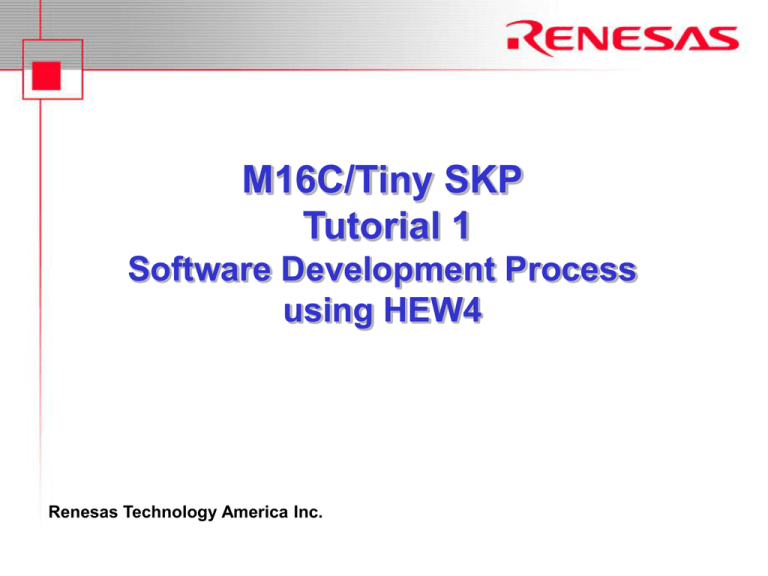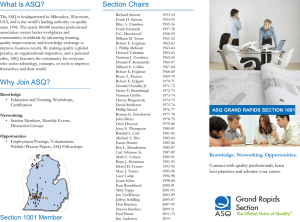SKP16CMINI28 Tutorial 1
advertisement

M16C/Tiny SKP Tutorial 1 Software Development Process using HEW4 Renesas Technology America Inc. Overview The following tutorial is a brief introduction on how to develop and debug programs using HEW4 (Highperformance Embedded Workshop) and other software and hardware tools included with the M16C/Tiny family of Starter Kits. These kits include SKP16C26A, SKP16C28 and SKP16C29-CL. Examples are shown throughout this tutorial using the SKP16C28. To get the most out of the Starter Kit, check out the references at the end of this tutorial. Note: This tutorial assumes the user has done the following: 1. Followed the ‘Quickstart Guide’ 2. Installed the SKP files, examples, and software tools in the default directories. 2 HEW4 M16C/Tiny Tutorial 1 The Development Process SKP16C/Tiny Board RAM 5. Correct errors & repeat process Flash User RAM Monitor RAM I/O Connector 1. Write programs using editor User Flash Monitor Flash 2. HEW automates compile & link ICD M16C/Tiny MCU Host PC HEW Editor window Project files HEW Build command Workspace and Source windows USB 3. HEW sends the machine code to the M16C/Tiny SKP during downloads and uses the symbols for source level debugging Correct Errors .c .h .a30 .inc Builder: Error reporting NC30 Compiler AS30 Assembler Options and Settings Machine Code LN30 Linker .r30 files 4. Debugging info sent back & forth Absolute file “.x30” HEW Debug interface Debug Symbols 3 HEW4 M16C/Tiny Tutorial 1 M16C/Tiny SKP Connectivity 4 HEW4 M16C/Tiny Tutorial 1 M16C/Tiny SKP Board Expansion Port Power LED Reset SW 8-character x 2-line LCD LCD Contrast Analog Adjust Pot JP2 Xout JP1 MCU Power 10MHz Crystal M16C/Tiny MCU User LED's RTA-FoUSBMON (ICD) Connector 32KHz Crystal Thermistor Expansion Port User Pushbutton Switches J1 5 HEW4 M16C/Tiny Tutorial 1 M16C/Tiny SKP Board Features M16C/Tiny MCU’s • 20MHz Operating Frequency at 3.0V – 5V, 10MHz Operating Frequency at 2.7V – 5V • 64~96kB Flash ROM, 2kB x 2 Virtual EEPROM, and 2~8kB RAM • Up to 71 GPIO with 4 Key-on Wakeup Inputs • Up to 8 Timers plus a Watchdog Timer • Up to 24-channel 10-bit ADC • 2 DMAC • Up to 5 SIO’s (supports I2C and SPI) • Voltage and Oscillation Failure Detection • Clock sources: Main (Xin), Sub (XCin), Internal R/C (ring) Onboard Features • • • • • LED’s (3 User, 1 Power) Removable 2-line x 8-character LCD Pushbutton Switches (3 User, 1 Reset) Thermistor and potentiometer on two A/D inputs I/O available on Expansion Ports 6 HEW4 M16C/Tiny Tutorial 1 ICD (RTA-FoUSB-MON) The ICD (In-Circuit Debugger) provides power and a USB interface to the Host PC and communicates commands and data to and from the M16C/Tiny SKP board via a synchronous serial interface. As a debugging tool (during program debug), the ICD + HEW downloads a small kernel (or ROM Monitor) program with the user program to the M16C/Tiny SKP Board . This kernel provides a communication interface between the M16C/Tiny MCU and the ICD + HEW Debugger application on MCU status. While the kernel uses some resources of the M16C/Tiny, the operation of the ICD is transparent to the user’s program. As a programming tool, the ICD + Flash-over-USBTM(FoUSB) Programmer can be used to download user programs to the M16C/Tiny MCU on the SKP Board and many other Renesas’ flash MCU’s (the ICD will support other Renesas flash MCU’s by downloading an MCU Monitor Image (MMI) file for a particular MCU thru HEW or FoUSB Programmer). NOTE: The kernel is only downloaded with the user program when Debugging but NOT when using the FoUSB Programmer. 7 HEW4 M16C/Tiny Tutorial 1 Development Tools HEW An Integrated Development Environment (IDE) that invokes all necessary software for building your project. Also communicates with the ROM Monitor Program (in flash on the MCU) for program debug NC30WA C-compiler (limited version of NC30). Conforms to ANSI C standards (see release notes on limitations) AS30 Relocatable Assembler Supports structured assembly language and a wide variety of macro instructions Flash-over-USB Programmer Flash programmer for Renesas Flash MCU’s. 8 HEW4 M16C/Tiny Tutorial 1 HEW IDE Overview HEW is an acronym for High-performance Embedded Workshop. When writing a microcontroller (or any computer) program, the program is usually split into multiple files to make it easier to read and understand. While exactly how the files are organized is up to the programmer, typically, the code is split up in a logical manner into various files (e.g. math functions in one file, serial port drivers in another, etc). After all the files in a project are compiled and assembled, a linker combines all the files into a single file. These steps can be tedious and repetitive. To make the process simple, we use an Integrated Development Environment (IDE) called HEW. 9 HEW4 M16C/Tiny Tutorial 1 Start HEW From the Windows Start menu, click on Programs > Renesas > High-performance Embedded Workshop > High-performance Embedded Workshop 10 HEW4 M16C/Tiny Tutorial 1 Open a HEW Workspace (1/3) 2. Click ‘OK’ button 1. After HEW opens, from the Welcome dialog box, select ‘Browse to another project workspace’ option, then click OK. 11 HEW4 M16C/Tiny Tutorial 1 Open a HEW Workspace (2/3) Using the Open Workspace dialog box, browse until you get to ‘C:\Renesas\SKP16C28\Sample_Code\Tutor1’ folder. Click on Tutor1.hws HEW workspace file and then click on ‘Open’ button. 12 HEW4 M16C/Tiny Tutorial 1 Open a HEW Workspace (3/3) HEW should look like the figure below. Menu bar Toolbars Workspace window Editor window Output window 13 HEW4 M16C/Tiny Tutorial 1 Workspace Window In the Projects tab, source files and header files are displayed. To change how dependencies are displayed, e.g. show dependencies for each source file, right-click within the window, and select Configure View. Try the following, click on ‘Show dependencies under each file’ and see what happens to files displayed on the window. To open a source file, double-click on it. 14 HEW4 M16C/Tiny Tutorial 1 Editor (Source) Window Right clicking on a file opens the Editor Options menu. Any opened source file within the workspace are shown on the Editor window. Line, total no. of lines, and column numbers are displayed here 15 HEW4 M16C/Tiny Tutorial 1 HEW Toolbars HEW is a powerful development environment with a lot of features and functionality. For this tutorial, the focus will be on features (i.e. Standard Toolbar) that will help you understand the M16C development process using HEW. Editor Toolbar2 Debug Toolbar1 Search Toolbar2 Version Control Toolbar2 Standard Toolbar Debug Run Toolbar1 Bookmarks Toolbar2 Templates Toolbar2 Notes: 1. M16C is supported by the Debug toolbars on HEW 4.x and above. 2. See HEW user’s manual about these toolbars. 16 HEW4 M16C/Tiny Tutorial 1 Standard Toolbar Build File Build All Build Current Current Debugger Session1 Configuration2 View Launch 2 Slave HEW Output1 View Workspace1 Stop Build File – builds3 a specific file Launch Debugger Build – builds files that were modified since last build Build All – builds the whole project regardless of whether there were modifications or not Stop – stops a running build process Current Configuration – build configuration (e.g. for debug, optimized, etc) Current Debugger Session – debug session configuration Launch Debugger – calls defined external debugger Notes: 1. Current Debugger Session, View Workspace, & View Output. 2. See HEW User’s manual for details. 3. A ‘build’ means running certain files (e.g. source files) under some tools (e.g. compiler, linker) to produce an output file (e.g X30 or MOT executable files for M16C) 17 HEW4 M16C/Tiny Tutorial 1 Build (re-build) Tutor1 Build Build All (re-build) Let’s rebuild the Tutor1 project into an executable module, click on the ‘Build All’ icon. This will re-compile and link all the source files. If any of the source files are modified, click on the ‘Build’ icon as this will only compile these modified files, which makes generating an executable module faster. Always perform a ‘Build All’ when the configuration has changed. Status, errors, messages, etc during a build process is displayed on the Output window... 18 HEW4 M16C/Tiny Tutorial 1 Output Window The major use of the Output window is to determine if any errors or warnings occurred, and where, during the build process. The no. of errors and warnings will show up in this window. You can then scroll up to find where the error(s) occurred. If no errors or warnings were found, ‘Build Finished’ will be displayed. Now that an executable file has been created, the next step is to download and run the program on the M16C/Tiny SKP Board and the ICD… 19 HEW4 M16C/Tiny Tutorial 1 HEW Debugging: Overview The new HEW4 integrates in-circuit Debugging. These features can be used to verify that the program we developed works exactly as we intended and when it does not, we can also use HEW to find out why. Breakpoints can be set in HEW to stop the program at certain points and verify registers, variables in memory, etc. The number of breakpoints will vary from MCU to MCU. For M16C/26A, /28 and /29 the maximum no. of breakpoints is 6. HEW allows “step” execution in our program, which means the program executes on a per line basis (whether in source level or machine code level). Various windows in HEW allow us to see register values and memory locations As the debugging features of HEW are fully integrated with the IDE, edit, compiling and debugging can be done in the same window. 20 HEW4 M16C/Tiny Tutorial 1 HEW Debugger Exercise • Download and run a program on the M16C/Tiny SKP board • General use of the Debugger including stepping and setting breakpoints • Within HEW, modify the program, rebuild, and run the updated program on the M16C/Tiny SKP board 21 HEW4 M16C/Tiny Tutorial 1 Connect Hardware Before debugging, connect the ICD to the M16C/Tiny SKP Board as shown. Connect the USB cable to the PC. On the ICD, the Power LED is on and the Status (Yellow) LED is blinking once a second (this means that the ICD USB driver was loaded correctly by WindowsTM). If not (i.e. blinking three times a second), the WindowsTM driver has not been loaded. Try disconnecting the mini USB cable, wait a few seconds, and then plug it back in. If this does not work, please check Appendix. A Troubleshooting in the M16C/Tiny SKP user’s manual. 22 HEW4 M16C/Tiny Tutorial 1 HEW debugging example Launch a debugging session by pulling down the menu in the “sessions” box and select M16C_R8C_FoUSB. 23 HEW4 M16C/Tiny Tutorial 1 Debug Init Window (1/2) Step 1. Click on ‘Refer..’ and select: Step 3. Click the ‘Run Mode’ tab ‘M30260F8A.MCU’ for SKP16C26A ‘M30280FA.MCU’ for SKP16C28 ‘M30290FA.MCU’ for SKP16C29 Step 2. Select USB 24 HEW4 M16C/Tiny Tutorial 1 Debug Init Window (2/2) For full debugging features, be sure ‘Sampling Mode1’ is selected. ‘Free Run Mode1’ is for real time execution of your program, but debugging is limited. Do NOT select for this tutorial. Now click ‘OK’ to start a HEW debug session (be sure hardware is connected). If you get an error, check all connections. See SKP user’s manual on ‘Troubleshooting’ for details. Note 1. See the HEW User’s Manual or Help for the differences between Sampling Mode and Free Run Mode. Also, see the ICD (RTA-FoUSB-MON) User’s Manual for details on how ICD works under these two modes. 25 HEW4 M16C/Tiny Tutorial 1 HEW Debug Session Edit window has not changed, but more buttons are available in the toolbar. Step in: Open ‘Init’ window Open Windows: (execute 1 line of code) Step over Step out Stop run Reset go Registers Memory I/O Reset CPU Breakpoints Go free Go to cursor Go (run) RamMonitor Status Display PC Go to cursor C Watch Asm Watch 26 HEW4 M16C/Tiny Tutorial 1 Download the executable file to the M16C/Tiny SKP Board (1/2) In the project window, RIGHT Click on the “tutor1.x30” file, then select ‘Download Module’… 27 HEW4 M16C/Tiny Tutorial 1 Download the executable file to the M16C/Tiny SKP Board (2/2) After download, 3 columns are added to the edit window View options: Source Mix Address column Disassembly 1. Double click here to set a breakpoint Double clicking here changes pass count 2. Add a few more breakpoints…. 28 HEW4 M16C/Tiny Tutorial 1 HEW Advanced Breakpoint Options 1. Click on breakpoint button By double clicking on an entry, you can enable or disable the Breakpoint, or use the buttons to configure them Breakpoint information can be saved and loaded between sessions 2. Click “Delete All” and close window 29 HEW4 M16C/Tiny Tutorial 1 Running Downloaded Program Click on the ‘Go’ icon to run the tutor1 program. Note the ‘STOP’ button turns red. On the board, LED’s D1, D2, & D3 will blink sequentially. Turning the Analog Adjust potentiometer clockwise increases the LED blink rate and turning it counter-clockwise decreases the LED blink rate. Click on the ‘STOP’ button. Open the register window. 30 HEW4 M16C/Tiny Tutorial 1 Program ‘Stepping’ Click to “step” a few lines Any register values that change turn red 31 HEW4 M16C/Tiny Tutorial 1 RAM Monitor Window The RAM Monitor displays the current value of the memory area shown on the window. It is updated at a preset value which can be modified by the user. By double-click an address you can change the address range you want to view. Open a RAM Monitor window Click the ‘GO’ icon. You can view the RAM as it is updating. This function is not available in “Free Run” mode. Click the ‘STOP’ icon before proceeding. With this window open, programs do not run in real time. 32 HEW4 M16C/Tiny Tutorial 1 Memory & C Watch Windows Open a Memory window. Open a C Watch window. By right clicking on a variable in the file edit window, you can add it to the watch window. The ‘Memory Window’ displays the location and contents of variables 33 HEW4 M16C/Tiny Tutorial 1 I/O Window Open the I/O window. If the I/O window is empty, right click inside the window and “load IO File” M16C28.io The ‘I/O Window’ allows you to view register contents and status of port pins 34 HEW4 M16C/Tiny Tutorial 1 Modifying the Program (1/2) If main_tutor1.c is not shown on the Editor window, double-click on it in the Workspace window and the file will be opened/displayed on the Source window. 35 HEW4 M16C/Tiny Tutorial 1 Modifying the Program (2/2) 1. Scroll down and find the ‘ta1_irq’ function. Note you can also find a function by clicking the ‘Navi’ tab in the project window and double click on the function name. 2. Change this line to ‘ta1 = (0x3FF – ad0);’. 4. Build the project again (the revised file is automatically saved). 36 HEW4 M16C/Tiny Tutorial 1 Load (re-load) Modified Program The HEW debugger will automatically detect that the program has been recompiled and ask if you wish to download again. Click ‘Go’. Turning Analog Adjust potentiometer on M16C/Tiny SKP Board clockwise decreases the LED blink rate. Turning it counterclockwise increases the blink rate. To stop a debug session but leave HEW open (i.e. edit only), re-open the default session. 37 HEW4 M16C/Tiny Tutorial 1 End of Tutorial This is the end of the tutorial. You can try downloading other sample programs from the \Sample_Code directory. For a tutorial on creating a new project, check Tutorial 2 for details. In addition, check out the references on the next page. Have Fun!! 38 HEW4 M16C/Tiny Tutorial 1 References and Recommended Reading All documents that came with the SKP can be found using the “Document Description” from the Start > Programs > Renesas > SKP16C2X menu. • • • • • User’s Manuals: Individual manuals for SKP16C26A, SKP16C28 and SKP16C29-CL. These documents provide details on the Starter Kits. HEW User’s Manual: To fully understand and get the most out of HEW, this is recommended reading. NC30 Version X.XX User’s Manual: Check this manual out for features specific to the NC30 compiler. M16C/26A, 28 & 29 Hardware Manuals: M16C/Tiny device specifications. RTA-FoUSB-MON User’s Manual: Provides details on the In-Circuit Debugger and Flash over USB Programmer. 39 HEW4 M16C/Tiny Tutorial 1 References and Recommended Reading • • • • • M16C/10/20/60 Series C Language Programming Manual: This is a great document for any level of programmer. The first chapter is an introduction and reference on the C language. The next chapter explains specifics of C programming with the M16C microcontroller. M16C/10/20/60 Series Software Manual: This document describes the instruction set and timing information for the M16C/20/60 series CPU cores. AS30 Version X.XX User’s Manual: Read this manual if you plan on writing programs in Assembly or when making changes to the startup file. Application Notes and Sample Programs: Application notes and other sample programs can be accessed from Renesas Technology America’s website: www.renesas.com. SKP updates: www.renesas.com/skp. 40 HEW4 M16C/Tiny Tutorial 1










